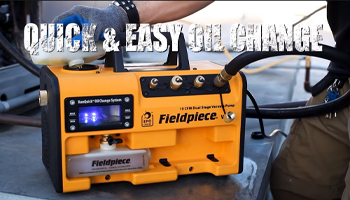
Because it changes everything.
We are all familiar with the rule of changing the oil in our vehicles, right? That’s because it makes them work more efficiently, run better, and last longer. The oil quality in your HVAC vacuum pump affects pump performance and helps you perform evacuations quicker — but only if you change it often. And we mean way more often than every three months. That’s because you could have the best vacuum pump on the market, but it only performs at peak efficiency if the oil is changed as soon as it starts to lose its effectiveness.
You see, the oil in your HVAC vacuum pump is the key ingredient to keeping the vane lubricated and creating a proper seal for an optimal vacuum, which then helps suck moisture and other non-condensables and contaminants from your system while performing an evacuation. Since vacuum pumps don’t have filters, once the oil is full of contaminants, pulling a vacuum is less efficient. This means that your evacuations take more time, and the mechanical parts of your pump could suffer.
Some oils are based on mineral oil and some are silicone-based synthetics, but depending on the pump you’re using, your oil could have many different formulations. All of them are well-refined and have a specific viscosity and low vapor pressure. That helps it lubricate the mechanism, remove moisture and contaminants from the system and gives it a smooth start-up at varying weather conditions. While most oils typically work well with any pump, it is good practice to use the manufacturer’s oil for peak pump performance.
And while not necessary as most pumps are capable of holding a deep vacuum with used oil, it is recommended to start an evacuation with fresh, clean oil every single time if possible.
Also, while you’re performing the evacuation, change the oil as soon as it becomes saturated with moisture or contaminants. This may need to be done several times during an evacuation and doing this consistently is critical to pulling a full, deep vacuum quickly. But how do you know when to change it? If you’re watching your vacuum gauge and the microns start to even out at a level higher than you want, or if the reading starts bouncing up and down, check your oil. If you notice discoloration – either lighter from moisture or darker from heat or contaminants – it’s time to change the oil.
At the end of the day, for the best possible outcomes you need large inner diameter (ID) vacuum-rated hoses; clean, dry vacuum pump oil; and a top-of-the-line HVAC vacuum pump like our VPX7. Armed with these tools, enjoy fast and effective oil changes every time!